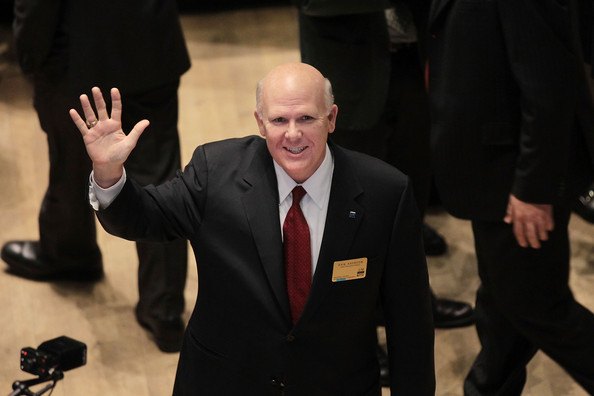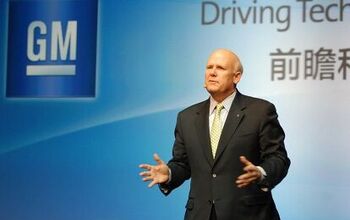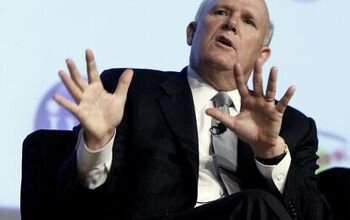The Case Against Akerson, Part 3 of 3: Loss Of Confidence
After part 1: Breach Of Trust, and part 2: Lack of Strategy, now the long-awaited final part.
In his book Car Guys vs. Bean Counters, GM’s best-known executive, Bob Lutz, describes the task facing newly-appointed CEO Dan Akerson:
“Akerson has inherited a company headed for success… Akerson does not have to “fix the business.” His role is not to run the operations but to set the overall direction, inspire the troops, and make sure the product development momentum continues… Akerson’s largest contribution could be to become the respected and liked spokesman, the personification of General Motors. Making GM more open, more human, more accessible and more likable is the last, great unfinished task.”
Lutz knows of what he speaks: after all, he was long the likable, humanizing public face of GM’s upper management. More importantly, he established the revamped product development system that has produced GM’s most competitive lineup in the modern era. However, Lutz knew and knows cars and the car business. Akerson knows how the telephone works.
Nobody, inside GM or out, has expected Akerson to radically reform GM’s core business; his only task was to provide a public face that inspired confidence in America’s automaker (Lutz offers Lee Iacocca and Alan Mulally as examples of auto executives who have played this role well). And yet, Akerson has not only failed to provide GM with a likable face, he has needlessly exacerbated public criticism of GM and inflamed internal divisions within the company.
Had Akerson taken Lutz’s advice, he would have focused on a few key issues: stabilizing GM’s executive ranks after Whitacre’s purges, supporting GM’s immensely talented product developers with the resources and respect they deserve, allowing PR messaging that supports attempts to revamp marketing, and distancing the company from its boot licking “Government Motors” stigma. Instead, Akerson ran his new marketing boss off for personal reasons (after he had been promised autonomy within the company), pushed his engineers into decisions with self-destructive results that he simply didn’t understand, put telecom cronies into positions they aren’t qualified for, promised to produce Volts in unsustainable (but political goal-supporting) volumes and inspired a wave of embarrassing leaks. In short, Akerson has managed to embody and amplify the product-ignorant, self-aggrandizing, morale-busting politics-over-market leadership that make up the worst stereotypes of GM managers, some of which may never have been true until the day Akerson took power. Lutz may have conquered the bean counters, but their destructive influence has been revived by the new telecom crowd. The bean counters knew the sometimes baffling mathematics of the auto business, the phonies know nothing.
This presents a fundamental danger to GM, if only because organizational culture begins at the top. But to make matters worse, Akerson is actively adding to the ranks of his loyalists, shutting out the profound expertise embedded in GM’s professionals in favor of sycophants and snake-oil dealing consultants. To be sure, the ranks of GM’s traditionalists still suffer from perennial turf battles, rivalry and misplaced loyalties; as a result, GM still needs a strong leader. But it needs a leader with credibility, both internally and externally. It needs a leader that knows when to push past parochialism but still knows when to trust the experts. A leader that understands his employees, his competitors and his customers.
Akerson’s profound disconnect with the business he is in, and thus the people he needs to work with him to make GM successful, is best encapsulated by his stated goal for the company. When Lutz was revamping GM’s product development program, and refocusing the company on the core of its business, the mission statement was adopted: “design, build and sell the world’s best vehicles.” Though simplistic, this motto provided GM with the kind of focus it had long been missing, not entirely unlike Mulally’s “One Ford” program, and it inspired a sea change in GM’s products. Now, not only is Akerson bashing his current portfolio of “aging” products, he has taken his eye off the ball by giving GM a new goal that seems ripped from the firm’s ignominious past: become the most valuable automaker in the world.
This uninspired non-goal can be met by any company. GM could declare victory tomorrow – as long as value is not measured by market cap.
This goal speaks mostly to Akerson’s shallow pomposity: having pushed himself into the top spot at GM without the first idea of what to do with the company, it makes sense for him to set a goal defined only by ambition. But it also displays his profound ignorance of the business: GM’s employees don’t need the “what” of a goal, they need the “how”… an insight that Lutz grasped and Akerson clearly does not. GM’s glorious past is inspiration enough, constantly reminding GM’s employees of the kind of market dominance that is possible. What GM needs is a leader who understands how companies develop ever-better products, how to earn the love of consumers by delighting them with quality and innovation, and how to compete head-to-head with the most fearsome global competitors.
Now that it is clear that Akerson is not that leader, now that he has lost the confidence of his employees and prospective customers, the question is “what comes next?” The answer: replace him as quickly as possible. Akerson’s predecessor, Ed Whitacre, has revealed that he nearly chose his head of North American operations Mark Reuss to be the next CEO, only rejecting him because of a perceived lack of seasoning. Instead of a young and experienced Reuss, we received an old an inexperienced Akerson, who, frankly, looks and acts older than he is.
Reuss commands respect within General Motors and the automotive community and the media at large. With a background in engineering and product development he is, more than anyone else at the top of GM’s management, the heir to Lutz’s product revolution. Meanwhile, whatever advantage Akerson’s age supposedly gives him has yet to produce a single notable accomplishment.
Despite his profound failures of both strategy and execution, Akerson has not yet fundamentally crippled GM. It remains chock-full of talent, it is well-positioned in various important global markets, and it is on the cusp of dramatically rehabilitating its reputation for uncompetitive product. In short, like Akerson himself, Reuss would be inheriting a company with a lot of things going for it. The key is reviving the company’s self-confidence and image with the public, tasks that the youthful and relatable Reuss has proven his ability at. But most importantly, the key is getting Akerson out before another crucial product launch is botched, before another strategically unwise investment is made, before GM’s reputation and unity is finally destroyed, turning GM into America’s Opel.
Part 1: Breach Of Trust. Part 2: Lack of Strategy.
Editor’s note: Renaissance_Man is a nationally and internationally known industry analyst who prefers to remain anonymous
More by Renaissance_Man
Latest Car Reviews
Read moreLatest Product Reviews
Read moreRecent Comments
- Calrson Fan Jeff - Agree with what you said. I think currently an EV pick-up could work in a commercial/fleet application. As someone on this site stated, w/current tech. battery vehicles just do not scale well. EBFlex - No one wanted to hate the Cyber Truck more than me but I can't ignore all the new technology and innovative thinking that went into it. There is a lot I like about it. GM, Ford & Ram should incorporate some it's design cues into their ICE trucks.
- Michael S6 Very confusing if the move is permanent or temporary.
- Jrhurren Worked in Detroit 18 years, live 20 minutes away. Ren Cen is a gem, but a very terrible design inside. I’m surprised GM stuck it out as long as they did there.
- Carson D I thought that this was going to be a comparison of BFGoodrich's different truck tires.
- Tassos Jong-iL North Korea is saving pokemon cards and amibos to buy GM in 10 years, we hope.






































Comments
Join the conversation
The evil done by the niche car flops wasn't restricted to their failure to attract buyers. Developing a new model is enormously costly. So gigantic pots of cash were diverted from, say, refining Impalas up from rental fodder. How many Silverado pickups had to be sold just to pay for the SSR? How many profitable Sierra sales were offset by the Solstice financial black hole? Did the Reatta debacle produce even one more customer for LeSabres and Park Avenues? You have to wonder if many models were OK'd for production just to protect the jobs of GM's huge management and hourly workforce. In other words, busy work.
I pity the next guy who takes over from Akerson. I hope GM isn't on the cusp of the big slide. With the scheduled closure of Oshawa in 2016, and the push to lobby for the Trans-Pacific Partnership trade treaty. It looks like Beijing is the tail that wags the dog. That together with the across the board market share decline... And how much blood and treasure did they blow on the Corvette and it's push-rod V8? Where's the youth market cars? Where's the wagons? Where's the FWD coupe with stick for the enthusiast who wants to enjoy driving year round in snow or shine? Everybody and their brother makes a grey slush-box sedan appliance, so what differentiates GM - other than three decades of swift decline?